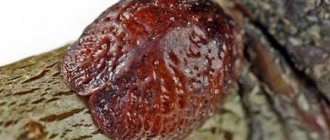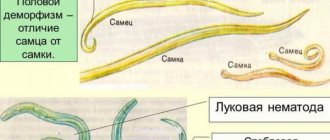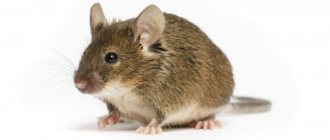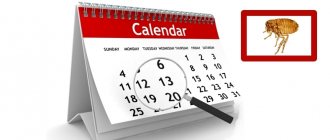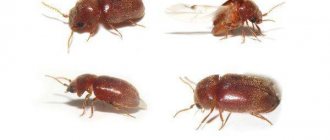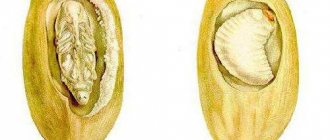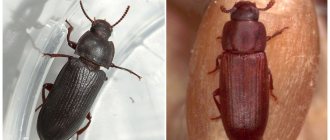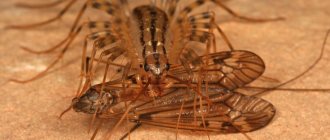The flour beetle is a small heat-loving insect that is a malicious pest of flour, grain, nuts, dried fruits and other food supplies. This pest can parasitize in large granaries, bakeries, shops and in residential buildings and apartments. In our country, it is widespread, and in the southern regions the parasite lives in any premises, and in the northern regions - only in heated ones.
Description
The Suriname mucoed is a very common type of household pest. The length of its flat and elongated body is about 2-3.5 mm. The integument is colored brown, which can have different shades: from light to dark. The surface of the chitin is matte with short, tightly fitting hairs. The head, like the body, has a flattened shape. There are antennae on the head, the length of which is no more than half the length of the body.
The elytra of the mucous eater are rectangular at the base; there are dotted grooves on the surface. The wings of this insect are well developed - it is capable of flight and is generally quite mobile.
The red flour beetle is heat-loving and for its normal reproduction and development it requires an air temperature that will be in the range from +25 to +27°C with a relative humidity of 65%. Under such conditions, 44 days are enough for the development of one generation.
On a note! If the air temperature drops below +16°C, mucous eaters stop reproducing! And at 0°C the insect dies within 22 days, at -5°C – 13 days!
Types of “unwanted new settlers”
You need to know the enemy by sight! The choice of battle tactics depends on the characteristics of the insect. To get rid of some bugs in the cereal, it is enough to deprive them of their usual living conditions, and they will die. Others are able to survive a nuclear war.
| Image | Type of beetle |
| Bread grinder The insect is red in color, 3 mm in length. He prefers baked goods, but will not refuse tea, buckwheat or rice. Due to their ability to fly, bread borers are difficult to hatch. | |
| Flour bug Dark cinnamon pests 4 mm in length. They settle in all types of flour, oatmeal and semolina. Flour bugs multiply very quickly, laying eggs disguised as white grains. | |
| food moth It looks like a butterfly, it reaches 1 cm in length. Thanks to its dark color and ability to fly, it is easy to camouflage and hide. It reproduces at a rapid pace, laying about 250 eggs per week. The hatched larvae spin a web that makes them easy to spot. Moths eat everything from flour to dried fruits. | |
| Red mucoed Red bug is 2 mm in length. Lives where it is warm and humid. It feeds on spoiled cereals and reproduces up to 7 times a year. Without food and suitable habitat, it dies. | |
| Weevil Black insects reach 5 mm in length. A distinctive feature is a long proboscis. Absolutely unpretentious insects - they eat everything and settle everywhere. They can go without food for a long time. |
Maliciousness
How dangerous is the Suriname mucoed? First of all, because it is capable of severely damaging large reserves of flour, cereals and grain in a fairly short period of time. In addition, this pest can often be found in dried fruits and vegetables, often in those that are already moldy.
On a note! In just one time, a female mucoed is capable of laying from 100 to 600 eggs. She lays her eggs on a food substrate, which the emerging larvae subsequently feed on!
Flour eater is also dangerous because it reduces the value of contaminated food products to absolute zero. Eating them is highly discouraged, as there is a high probability of an allergic reaction.
Preventive actions
No one is safe from the invasion of the Suriname mucoed. To minimize the occurrence of the ubiquitous household pest, follow a number of simple preventive measures:
- maintain cleanliness in the kitchen;
- store cereals in a tightly closed container;
- dried fruits must be kept in the refrigerator;
- ventilate the kitchen frequently;
- freshly purchased bulk products should be kept in the freezer for 2-3 days before being sent for storage;
- ensure dryness in the kitchen, do not allow moisture to arise;
- periodically conduct a thorough audit of food products;
- Always keep garlic cloves, bay leaves, sprigs of dry chamomile or rosemary in your kitchen furniture;
- Treat kitchen furniture with vinegar solution 1-2 times a month.
Have you ever had to fight a garden flour beetle?
Was the caseNever
Flour-eating bugs are dangerous and destructive parasites. Once infected, food becomes completely unsuitable and dangerous for consumption. Therefore, when this insect first appears, it is necessary to immediately begin to completely expel it from the apartment.
Ways of penetration of mucoed into the apartment
Initially, the mucous beetle lives, of course, in the wild, but does not live long. Most often it can be found under the bark of trees and in rotten stumps. If possible, it immediately moves to industrial enterprises: mills, barns, bakeries, feed mills, etc. There the development of the insect is more successful.
On a note! Despite the fact that the flour beetle is a threat to various products, it will only damage certain stocks - the moisture content of which is at least 15-16%! If the product is too dry, then the insects gather in groups and contaminate it with excrement and shed shells, thereby increasing the moisture content of the stock!
Where do flour eaters come from in our kitchens? The pest usually enters apartments in the following way:
- in bags with contaminated flour and cereals, from where they are subsequently distributed throughout the house;
- flour beetles are often found in packages of low-quality grain feed and pet food;
- Within an enterprise and even a populated area, mucoids can spread through active dispersal.
Thus, it turns out that in most cases we ourselves bring the parasite into our home along with contaminated food. But, be that as it may, when you find a flour beetle in the kitchen cabinet, you need to clearly know how to get rid of it, because only timely and correct measures will help you quickly remove it from the apartment.
Ways to get rid of bugs
To get rid of bugs, it is necessary to carry out a whole range of measures to destroy not only them themselves, but also their offspring, waste products. And first of all, this is, of course, to carry out high-quality cleaning. Armed with rags and sponges, you will have to open all the kitchen cabinets and empty and treat all the shelves and drawers.
It is necessary to carefully sweep away any remaining grains that may have spilled and simply wipe everything with a dry or slightly damp cloth. After this you can proceed to processing:
Table vinegar copes well not only with adult individuals, but also with their larvae and eggs.
Therefore, you need to dilute vinegar 9% approximately 1:1 with plain water and wipe all surfaces with this solution
And not only the horizontal shelves themselves, but also the vertical ones, including the doors.
Particular attention should be paid to the joints. If your furniture allows it (not varnished), you can pour the solution into a spray bottle and spray hard-to-reach joints, for example, in the area of hinges on doors.
Then dry the furniture thoroughly so that it does not get wet or deteriorate.
Soda-saline solution can be used instead of vinegar
Dissolve a couple of tablespoons of ordinary rock salt and a spoonful of baking soda in a liter of warm water, stir well, the solution is ready.
Now let's move on to storage containers:
- If you choose glass or plastic containers for storage, then you need to not only wash them, but also thoroughly rinse them with boiling water, which will kill the bug eggs.
- If you store cereals in fabric bags, then they should not only be washed, but also boiled.
- It’s better not to do anything with plastic bags, but simply throw them out and straight into the garbage disposal, and not into the trash can in the kitchen, from where the parasites will quickly crawl back out.
After the main shelters of the bugs have been eliminated and processed, it is worth moving on to the remaining items. It is advisable to wipe everything with vinegar solutions: refrigerator, microwave and other appliances and furniture:
- Pyrethrum helps well; it is a flower powder that is made from Caucasian chamomile, absolutely organic and safe for humans and pets. It should be sprayed carefully in cabinets. To do this, you can simply pour a little onto a dry palm and blow gently in the direction of the shelf you need. Make sure that the powder gets into the cracks and joints.
- If your pest is a food moth, then in addition to the procedures described above, it is necessary to add treatment with any chemical agent for ordinary moths. Moreover, you also need to spray carpets, rugs, and upholstered furniture, if any.
If you choose glass or plastic containers for storage, then you need to not only wash them, but also thoroughly rinse them with boiling water, which will kill the bug eggs
Fighting methods
So, before using any poisonous or repellent remedy for mucous, you must do the following:
- empty kitchen cabinets and nightstands of food, dishes and other items and remove all spilled supplies - flour, cereals, etc.;
- Dilute a tablespoon of vinegar in a liter of water and wipe all surfaces of the kitchen unit with the resulting solution;
- in order to destroy mucous eaters that could hide in hard-to-reach places, you need to bring the water to a boil and pour boiling water over all the cracks (if you are absolutely sure that this measure will not harm your furniture!);
- Wash jars and other containers in which flour and cereals are stored thoroughly with laundry soap and treat with boiling water;
- if supplies were stored in linen bags, then the latter should be soaked in a salt solution, and then dried without rinsing;
On a note! After such an event, female mucoeds will no longer lay eggs on the bags!
Folk remedies
Now it’s time to choose what to poison the mukoeater with. If there are few insects, then folk remedies can be used to destroy them.
- These pests do not like the smell of bay leaves and garlic.
- Pyrethrum - this powder is a real poison for the mucous eater. You can buy it at the pharmacy. The powder is scattered on the shelves of kitchen cabinets or placed in fabric bags. After one and a half to two weeks, the old drug should be thrown away and fresh powder should be added. Two treatments will be enough.
- You can also remove beetles using simple bait. Mix equal amounts of borax, powdered sugar and any finely ground cereal. We lay out the finished mixture on pieces of paper in the kitchen cabinets. Flour eaters will begin to eat the poisoned bait and die from the poison present in its composition.
- It is recommended to use sticky traps for mucous beetles. They are placed in the kitchen and other rooms where the parasite was found and are changed as they are filled.
Advice! They will work especially effectively together with repellent substances - the beetle runs away from the unpleasant odor and ends up in a sticky trap!
Insecticides
In most cases, the above-described means and methods help get rid of the Surinam mucoed, and both poisons and repellents show high effectiveness. However, if the insects have managed to breed and there are too many of them, then in this case you cannot do without insecticides.
So, for mucoed you can use:
- "Dichlorvos";
- "Raptor";
- "RAID";
- "Combat" etc.
All of them are used according to the same scheme. First, food and utensils should be removed from the premises and access to people and animals should be restricted. Next, close the windows and spray the product evenly on all surfaces, including the inside of cabinets and bedside tables. After treatment, the room is closed and the time prescribed in the instructions is maintained. Finally, wet cleaning is carried out.
It is quite possible to destroy a mucous eater in an apartment on your own. The main thing is that if a pest is detected, immediately take steps to eliminate it, and then carefully inspect cereals, flour and other bulk products purchased in the store.
Professional products
Today, manufacturers offer many different repellents to combat pests. You can’t do without them especially when the bugs have multiplied in large numbers. The most effective means of control are “Raptor”, “Combat”, “Dichlorvos”, “RIDE”.
The procedure for getting rid of the mucous beetle is the same for all repellents:
- empty all cabinets of contents;
- remove pets from the kitchen and limit access to children;
- close windows and doors;
- spray the product inside cabinets and cabinets;
- maintain the processing time specified in the instructions;
- Thoroughly rinse treated cabinets and cabinets.
Before processing, contaminated products should be removed from the apartment and thrown into the trash. Newly purchased products should be inspected regularly to ensure that the mucous beetle infestation does not happen again.
Laemophloeus testaceus F.
Placonotus testaceus, Cryptolestes testaceus, Cucujus testaceus
rufous grain beetle
Coleoptera (Beetles) - Coleoptera
The red flour beetle is a small rusty-yellow beetle. The body is covered with hairs. Pest of grain products with high humidity. Inhabitant of mills, bakeries and feed mills.
The author has repeatedly heard how laboratory assistants at grain processing enterprises called all insects similar to the red mulled beetle “saffron milk beetles”, referring primarily to this one, but, as a rule, classifying many small beetles as the red mulled beetle.
In foreign Internet sources, the red mucoed is considered one species with the short-whiskered (red) mucoed; in most domestic sources, the red mucoed is described as a separate species. (Compiled)
Click on photo to enlarge
Harm to humans
In flour, cereals and other products you can see dark-colored bugs - most likely, these are the Suriname flour beetle. This pest grows to only 3.5 mm and is difficult to notice in products with the naked eye. To get acquainted with its external features, you should carefully consider what the Suriname mucoed looks like in the photo. It differs from another known relative - .
The development of the Suriname beetle goes through the same stages as most insects: egg, larva, pupa and adult insect. The pest prefers to settle in mills and granaries. From here it migrates to bakeries, bakery production, warehouses, store shelves and into customers' homes.
The lifespan of the insect is about 3 years (in favorable conditions). During this time, it is capable of laying up to 600 eggs. One clutch contains 30 eggs, which in just 30-75 days produces the same number of insects capable of reproduction.
The eggs of the pest are very small - no more than 1 mm. Therefore, when purchasing and storing cereals, it is very difficult to see. Contaminated goods should not be used for food even after heat treatment. To find out why this little bug is dangerous to humans, just look carefully at the composition of spoiled cereal: bugs and larvae crawl there, and there is a huge amount of feces. Eating such cereals can provoke severe allergies or cause poisoning.
What to do if there are bugs?
First of all, check all the products. Most often, housewives remember flour and cereals, but insects can hide in other places.
Where to look for bugs?
Bugs are nosy and almost omnivorous insects. Therefore, if you catch your eye at least one, you need to urgently organize an audit and look for them in all sorts of “hiding places”:
- beans - favorite habitat;
- bread;
- flour and cereals;
- dried fruits;
- spices (they even live in pepper bags);
- vegetables (soft rotting onions are a reason to take a closer look);
- tea and coffee;
- cookie;
- cracks in furniture and window sills;
- kitchen appliances;
- first aid kit (bugs are susceptible to mustard plasters).
After a thorough home inspection, you need to do the following:
If few insects are found, some of the products can be saved by calcining them in the oven or keeping them in the freezer for a day (then the flour or cereal must be sifted through a sieve). Heavily contaminated supplies will have to be disposed of.
Legumes need to be immersed in salt water and wait until the beetles and their offspring float to the surface, after which the water should be drained and the grains dried.
The garbage along with the bugs must be taken out immediately before they crawl into the cracks of the floor.
- Place unaffected products into glass jars and close tightly.
- Clear the cabinets of food and rinse with vinegar water (1 teaspoon per liter).
- Disinfect all rooms to prevent insects from breeding. Pouring boiling water into the cracks (for wooden floors) gives good results.
The main thing is to make sure that all insect habitats are declassified.
Video
Simple and affordable methods will help you cope with pests in the kitchen. To understand the intricacies of their use, watch the presented videos:
https://youtube.com/watch?v=NzJAWDvm5Zw
Young mother, wife and part-time freelancer. Being a lawyer by training, I am accustomed to collecting and providing the most complete and reliable information. Constantly improves in the professional field and strives for personal growth and development.
Found a mistake? Select the text with the mouse and click:
Threads made of gold and silver, which were used to embroider clothes in the old days, are called gimp. To obtain them, the metal wire was pulled for a long time with pliers to the required fineness. This is where the expression “to drag out the rigmarole” came from - “to do long, monotonous work” or “to delay the completion of a task.”
Before removing various stains from clothing, you need to find out how safe the selected solvent is for the fabric itself. It is applied in a small amount to an inconspicuous area of the item from the inside out for 5-10 minutes. If the material retains its structure and color, you can move on to stains.
If your favorite things show the first signs of gestation in the form of untidy pellets, you can get rid of them using a special machine - a shaver. It quickly and effectively shaves off clumps of fabric fibers and returns things to their proper appearance.
Fresh lemon is not only suitable for tea: clean dirt from the surface of an acrylic bath by rubbing with half a cut citrus, or quickly wash the microwave by placing a container of water and lemon slices in it for 8-10 minutes at maximum power. The softened dirt can simply be wiped off with a sponge.
There are special traps to combat moths. The sticky layer with which they are covered contains female pheromones that attract males. By sticking to the trap, they are eliminated from the reproduction process, which leads to a decrease in the moth population.
The dishwasher cleans more than just plates and cups. You can load it with plastic toys, glass lamp shades and even dirty vegetables, such as potatoes, but only without using detergents.
The easiest way to remove scale and carbon deposits from the soleplate of the iron is with table salt. Pour a thick layer of salt onto the paper, heat the iron to maximum and run the iron over the salt bed several times, applying light pressure.
The habit of using an automatic washing machine “sparingly” can lead to the appearance of an unpleasant odor in it. Washing at temperatures below 60℃ and short rinses allow fungi and bacteria from dirty clothes to remain on internal surfaces and actively multiply.
Stretch ceilings made of PVC film can withstand from 70 to 120 liters of water per 1 m2 of their area (depending on the size of the ceiling, the degree of its tension and the quality of the film). So you don’t have to worry about leaks from neighbors above.
>
Morphology
Imago . Body length 1.5 – 2.5 mm. The beetle is rusty-yellow in color, the body is narrow, covered with silky hairs. The head is almost equal in width to the chest, the antennae are equal in length to the body and are widely spaced to the sides. [6]
Beetles have wings and fly well. [3]
The larvae are cream-colored, covered with long hairs, the tip of the abdomen is reddish, with two hook-shaped outgrowths, the length of the adult larva is up to 4 mm.
The pupa is light yellow or cream in color, the body is wide, with long hairs, and at the posterior end there are two spiny outgrowths. The length of the pupa is 1.5-2 mm. [2]
